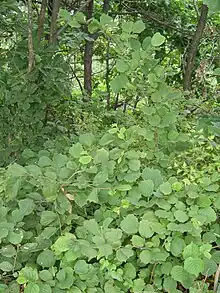Corylus heterophylla
Corylus heterophylla, the Asian hazel, is a species of hazel native to eastern Asia in northern and central China, Korea, Japan, and southeastern Siberia.[1]
| Asian hazel | |
|---|---|
 | |
| Scientific classification | |
| Kingdom: | Plantae |
| Clade: | Tracheophytes |
| Clade: | Angiosperms |
| Clade: | Eudicots |
| Clade: | Rosids |
| Order: | Fagales |
| Family: | Betulaceae |
| Genus: | Corylus |
| Species: | C. heterophylla |
| Binomial name | |
| Corylus heterophylla | |
It is a deciduous shrub or small tree growing to 7 m (23 ft) tall, with stems up to 20 cm (8 in) thick grey bark. The leaves are rounded, 4–13 cm (1+1⁄2–5 in) long and 2.5–10 cm (1–4 in) broad, with a coarsely double-serrated to somewhat lobed margin and an often truncated apex. The flowers are wind-pollinated catkins; the male (pollen) catkins are pale yellow, 4 cm (1+1⁄2 in) long, while the female catkins are bright red and only 1–3 mm (1⁄16–1⁄8 in) long. The fruit is a nut produced in clusters of 2–6 together; each nut is 0.7–1.5 cm (1⁄4–1⁄2 in) diameter, partly enclosed in a 1.5–2.5 cm (1⁄2–1 in) long, bract-like involucre (husk).[1][2]
It is very similar to the closely related common hazel (C. avellana) of Europe and western Asia, differing in the leaves being somewhat more lobed.[2]
Uses
The nut is edible, and is very similar to the common hazel nut; it is cultivated commercially in China.[1]
References
- Flora of China: Corylus heterophylla
- Bean, W. J. (1976). Trees and Shrubs Hardy in the British Isles 8th ed., vol. 1. John Murray ISBN 0-7195-1790-7.
